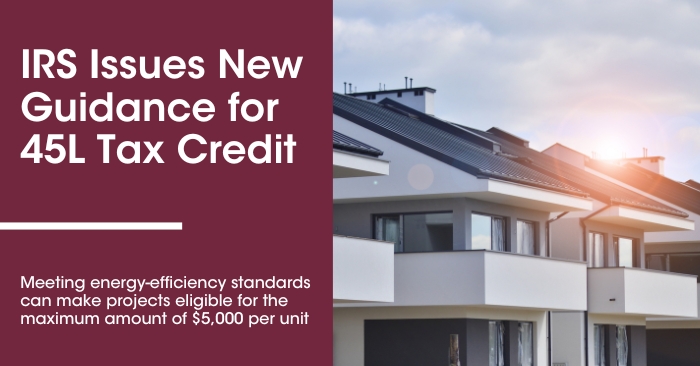IRS Issues New Guidance for 45L Tax Credit
Meeting energy-efficiency requirements can make projects eligible for the maximum amount of $5,000 per unit
The Internal Revenue Service (IRS) recently issued new guidance with Notice 2023-65, surrounding the 45L Tax Credit that impacts how single-family, multifamily, and manufactured homes qualify for this Green Building Tax Incentive.
The main purpose of the 45L initiative is for eligible developers (i.e., single and multifamily developers, condo developers, affordable housing developers, etc.) to be rewarded with tax credits for constructing energy-efficient homes and dwelling units. Based on specific energy-efficiency standards set by the government, multifamily developers can qualify for up to $5,000 per apartment unit, depending on the energy efficiency levels the unit achieves.
Why Energy Star and ZERH Certification Matters
Developers looking to claim 45L tax credits must ensure their projects are certified by a qualified third-party verifier like KBKG as meeting certain energy efficiency and construction related requirements. By meeting these requirements, developers (i.e., single and multifamily developers, condo developers, affordable housing developers, etc.) become eligible to claim the credit and increase their cash flow through a reduction in tax liability.
Based on the new guidance, dwelling units must now meet strict criteria for insulation, windows, heating and cooling systems, and appliances. Adhering to these standards means developers have shown a commitment to energy efficiency, making the constructed properties environmentally friendly and cost-effective to maintain and operate for homeowners and tenants. While net-zero energy usage is not required, dwelling units specifically designed to be solar-ready are eligible for increased incentives.
Qualifying for 45L
Qualifying for this credit means homes must meet certain energy efficiency criteria and either be sold to a homeowner or leased to a tenant for use as a residence. Starting January 1, 2023, both single and multifamily developers can be eligible for the maximum value of up to $5,000 for each dwelling unit.
To receive the maximum value of the 45L Tax Credit, developers must align their homes and dwelling units with high energy efficiency standards and ensure qualified properties represent a significant leap forward in green building practices.
How to Claim 45L
A third-party energy and tax consultant, such as KBKG, is required to certify a housing development’s qualification for this Green Building Tax Incentive. Engaging with tax professionals and energy consultants prior to the start of construction is a necessary step in the process. The consultation beforehand serves as an assessment of the development’s current design and ensures it follows the energy standards outlined in the new guidance.
KBKG offers a team of certified professionals, along with an in-house, multidisciplinary group of energy consultants, third-party verifiers, and industry-leading tax specialists. KBKG is on a small list of rating companies in the U.S. trained for both single and multifamily homes nationwide. Prospective candidates interested in claiming the 45L Tax Credit should contact a KBKG expert for further guidance and support.


